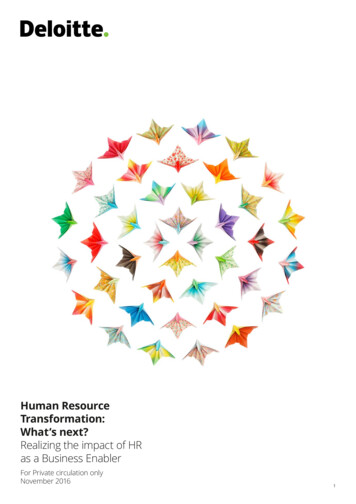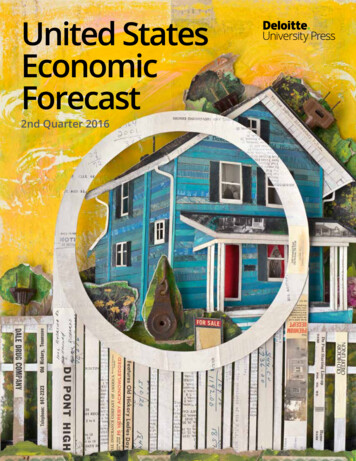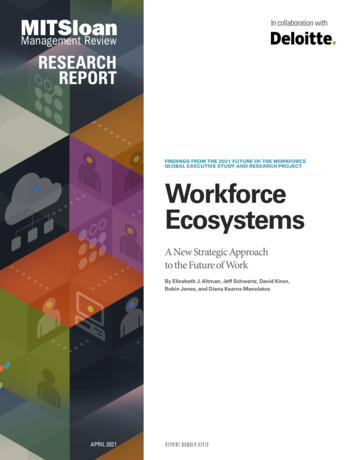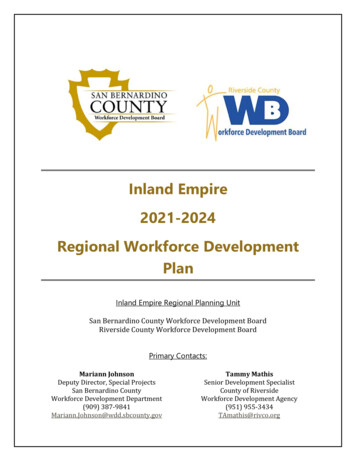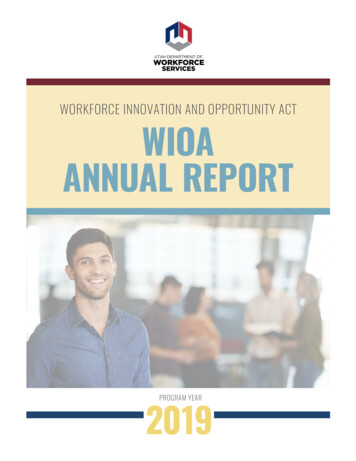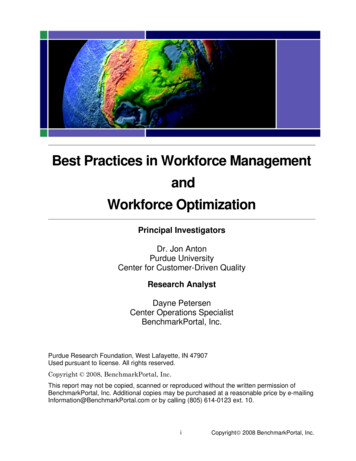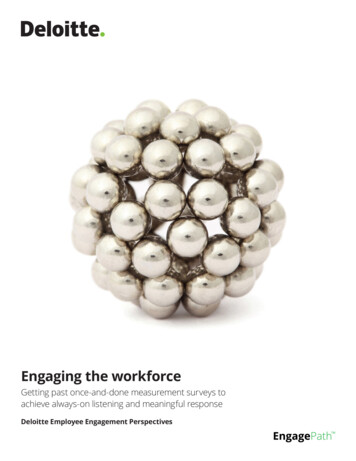
Transcription
Engaging the workforceGetting past once-and-done measurement surveys toachieve always-on listening and meaningful responseDeloitte Employee Engagement Perspectives
Deloitte Employee Engagement Perspectives / Engaging the workforceWhat is employeeengagement?Organizations are increasingly talking about engagement,but not everyone is defining and measuring it in the same way.Engagement typically refers to an employee’s job satisfaction,loyalty, and inclination to expend discretionary effort towardorganizational goals.1 It predicts individual performance andoperates at the most fundamental levels of the organization—individual and line—where the most meaningful impactcan be made. Workplace culture is related, though operateson a different level. Culture is a system of values, beliefs,and behaviors that shape how real work gets done within anorganization. It predicts company performance, and is shapedand cultivated at the most senior levels of the organization.1
Deloitte Employee Engagement Perspectives / Engaging the workforceThe vast majority of executives responding toour Global Human Capital Trends survey ratedengagement as a priority for their companies.More than8 in10executives rated engagementas important or very important.2But company actions regarding engagementdon’t always support that level of importance.Just64%of respondentssay they are measuring employeeengagement once a year.3Andone in five(18%)said their companies don’t formallymeasure employee engagement at all.4As the workforce and its expectations about work evolve rapidly, employersshould start treating engagement as the business-critical issue it is.1
Deloitte Employee Engagement Perspectives / Engaging the workforceWhy does employeeengagement matter ?Engagement is critical because it is directly linked to business outcomes.Consider research on how engagement affects productivity, revenue growth,and performance and retention.American businesseslose productivity worth 300 billionannually due to disengaged workers.5ProductivityOrganizations with highlyengaged employeesexperienced a3-year revenuegrowth rate2.3 timesgreaterRevenuegrowththan average(20.1% growth vs. 8.9% growth).6Performanceand retentionOrganizations withengaged workers mayhave employees who are57%more effectiveand87%less likely to leavethan organizations withlow engagement.7This retention aspect is particularly pertinent.The ease of exploring job opportunities online and a new acceptance (sometimes even an expectation) that employees willchange jobs more frequently than in the past means employers need to think about ways to motivate employees to stay.An organization’s ability to keep employees engaged is a valuable retention tool and a hedge against voluntary turnover.2
Deloitte Employee Engagement Perspectives / Engaging the workforceChanging workforce demographics andincreased diversity also highlight the challengeand criticality of employee engagement.Today’s organizations should try to attract, embed,and retain a workforce encompassing workers froma variety of demographics and a blend of full-time,part-time, contract, and contingent employees.Despite this reality, research finds that:Only11%of companies have a highly inclusive work environment8 —it’s hard to feel engaged if you don’t feel included.And while aboutone in fourMillennials (26%) surveyedrated employee satisfaction/loyalty/fair treatment asthe most important valuesupporting a business’slong-term success,9only4%of business and HRleaders surveyedbelieve they are verygood at engagingMillennials andother generations inthe work environment.103
Deloitte Employee Engagement Perspectives / Engaging the workforceMeasuring andmanaging engagementshould be an ongoing,always-listeningprocess that enablesorganizations to activelyhear and respond totheir employees in timelyand focused ways.4
Deloitte Employee Engagement Perspectives / Engaging the workforceMeasuring engagementThe problem withonce-and-done: tooinfrequent, too slow.Instead, measurefrequently and tieresults to action.Annual employee engagement surveyshave long been the norm in manyorganizations. While yearly touchpoints arebetter than not measuring engagement atall, they may leave a lot to be desired. Theprocess can actually build distrust in theworkforce if employees see engagementsurveys as a compliance-motivated exerciseinstead of a genuine desire to respondand improve. The cycle time, particularly inlarge organizations, can also be quite long.By the time you disseminate the survey,gather the results, interpret the results,and plan interventions, the problems mayhave passed, the damage from the issuesidentified is done, or new issues havesurfaced that have not been captured.To be effective, measuring and managingengagement should be an ongoing,always-listening process that enablesorganizations to actively hear andrespond to their employees in timelyand focused ways. This might includenot only using a comprehensive baselinesurvey but also taking more frequentpulses at least quarterly to dig into theissues. These pulses can be targeted tomeasure aspects of the job directly tied toengagement, organizational priorities, orhot-button issues.5
Deloitte Employee Engagement Perspectives / Engaging the workforceWhat drives engagement?Deloitte’s years of research and experience withhundreds of organizations suggests that five mainindices and underlying attributes work togetherto drive engagement and make organizations“simply irresistible” to the workforce—bothprospective and current employees.The Simply Irresistible sitive workenvironmentGrowthopportunityTrust inleadershipAutonomyClear andtransparent goalsFlexible workenvironmentTraining andsupport on the jobMissionand ilitatedtalent mobilityContinuousinvestment in peopleSmall,empowered teamsInvestment indevelopment of managersCultureof recognitionSelf-directed,dynamic learningTransparencyand honestyTime for slackAgile performancemanagementFair, inclusive, diversework environmentHigh-impactlearning cultureInspirationCross-organization collaboration and communicationSource: Bersin by Deloitte.6
Deloitte Employee Engagement Perspectives / Engaging the workforceThe Simply Irresistible Organization:11What these dimensions measureMeaningful work that alignsemployees to their strengths,gives them a sense of purposeand empowerment, and enablesthem with the tools and autonomythey need to develop and succeed.A positive work environmentthat is flexible, collaborative,humane, and inclusive, with benefitsand programs that allow work to fit intoemployees’ lifestyles and an emphasison maintaining a culture of recognition.Supportivemanagementthat guides and empowers itsemployees by setting clear goals,coaching for high performance,developing future leaders, andproviding continuous feedback.Trust in leadershipdue to inspirationalleaders who invest in theirpeople, communicate honestly,and fulfill the organization’smission, vision, and purpose.Growth opportunityfor continuous learning,professional development,and career progression, includinga focus on supporting andfacilitating internal mobility.Underlying all of these are collaboration and communications that provide andpromote simple and logical processes alongside the resources that employeesneed to do their jobs.7
Deloitte Employee Engagement Perspectives / Engaging the workforceFrom reactive once-and-doneto proactive always-listeningBuilding and sustaining an engaging environment is an ongoing, proactiveprocess. If companies commit to simplify and streamline their processesand leaders from the most senior levels to frontline managers demonstratethe desire to listen, respond, and improve, the workforce is more likely to bereceptive and supportive too—which are themselves forms of engagement.To work toward that goal, companies should consider the following:Review legacy employeeengagement providersto confirm they meet the needs ofthe organization’s changing workforcedemographics and can measurethe current employee population.Measure engagement for a baselineunderstanding of where engagement is broadly, andalso further measure themes via pulse surveys to movethe organization from a “once and done” approach to“always listening.” Pulsing can help organizations quicklygather insight and feedback to determine interventionsdesigned to support higher engagement.Address engagement issuesquickly, at the business unit or teamlead level, where engagement reallymatters and managers can make ameaningful impact on their staff’slevel of attachment toward their job,coworkers, and organization.Link engagement measures tobusiness outcomes (for example,performance management results orsales data) to identify problem themesat the most fundamental level and tohelp sustain engagement over time.Employee engagement extends beyond employee satisfaction—and an active and inclusiveapproach can capture the distinction that will move the needle where it matters most.Frequent and agile outreach will gather the objective insights and feedback required to understand strengths andgaps. This understanding can then be used to drive the behaviors needed to improve employee engagement in atimely and meaningful way.8
Deloitte Employee Engagement Perspectives / Engaging the workforceContactsJosh BersinPrincipalBersin by DeloitteDeloitte Consulting LLPjbersin@deloitte.comAlyson DaichendtManaging Director, Human CapitalDeloitte Consulting LLPadaichendt@deloitte.comMarc KaplanLeader, Organization Transformation and TalentDeloitte Consulting LLPmkaplan@deloitte.comEndnotes1.See Bersin by x?id 14388.2.Global Human Capital Trends 2016 report, The new organization: Different by design, Deloitte University Press, tml.3.Ibid.4.Ibid.5.Ologbo, A.C., and Sofian, S (2012). Individual factors and work outcomes of employee engagement. Procedia Social and Behavioral Science.6.Schaufenbuel, K. (2013). Powering your bottom line through employee engagement. UNC Kenan-Flagler Business School.7.ADP Staff in Schaufenbuel, K. (2013). Powering your bottom line through employee engagement. UNC Kenan-Flagler Business School.8.Sherman Gar, Stacia, The diversity and inclusion benchmarking report: An analysis of the current landscape, Bersin by Deloitte, h/?docid 17320.9.The 2016 Deloitte Millennial Survey: Winning Over the Next Generation of bout-deloitte/articles/millennialsurvey.html.10. Global Human Capital Trends 2016 report, The new organization: Different by design, Deloitte University Press, tml.11. Bersin, Josh, Becoming irresistible: A new model for employee engagement, Deloitte Review, Issue 16, nt-strategies/.9
www.deloitte.com/engagepathAs used in this document, "Deloitte" means Deloitte Consulting LLP, a subsidiary ofDeloitte LLP. Please see www.deloitte.com/us/about for a detailed description ofthe legal structure of Deloitte LLP and its subsidiaries. Certain services may not beavailable to attest clients under the rules and regulations of public accounting.This communication contains general information only, and none of DeloitteTouche Tohmatsu Limited, its member firms, or their related entities (collectively,the “Deloitte Network) is, by means of this communication, rendering professionaladvice or services. Before making any decision or taking any action that may affectyour finances or business, you should consult a qualified professional adviser.No entity in the Deloitte Network shall be responsible for any loss whatsoeversustained by any person who relies on this communication.Copyright 2016 Deloitte Development LLC. All rights reserved.
5. Ologbo, A.C., and Sofian, S (2012). Individual factors and work outcomes of employee engagement. Procedia Social and Behavioral Science. 6. Schaufenbuel, K. (2013). Powering your bottom line through employee engagement. UNC Kenan-Flagler Business School. 7. ADP Staff in Schaufenbuel, K. (2013). Powering your bottom line through employee .



